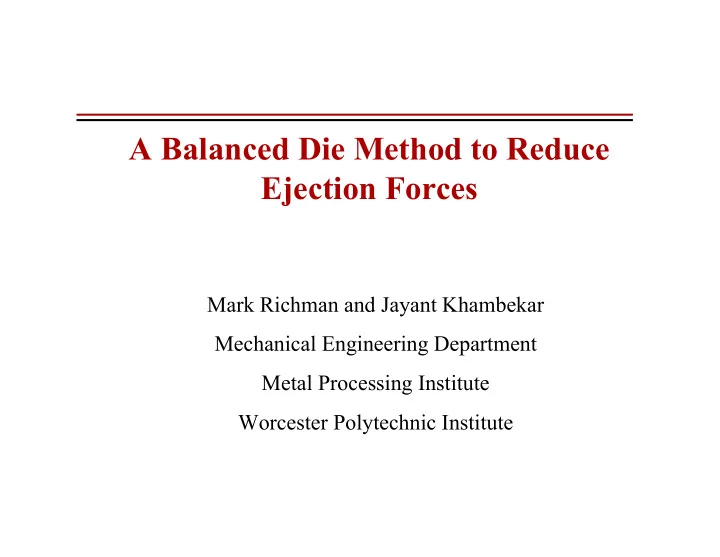

A Balanced Die Method to Reduce Ejection Forces Mark Richman and Jayant Khambekar Mechanical Engineering Department Metal Processing Institute Worcester Polytechnic Institute
Outline of Presentation • Overview of the Balanced Die – overview of compaction-to-ejection process – description of the balanced die method • (Holownia [1996]) – qualitative effects (intuitive) • Brief description of the ejection model • Results: Prediction of ejection forces – unchanging radial pressure – increasing radial pressure – qualitative comparison to experimental results • Summary
Overview: Compaction to Ejection Compaction Springback Ejection Axial Axial Elasticity Solution of Pressures Pressures 3 Misfit Cylinders Radial Radial Radial Pressures Pressures Pressures Added Radial Frictional Frictional Expansion Stresses Stresses Reduced by the Balanced Die
The Balanced Die upper punch cylindrical piston die carrier die wall metal powder L h rubber sleeve core rod lower punch
Balancing Pressure Pressure σ exerted by rubber sleeve σ H R o R i R
Radial Interfaces R i R o L R CORE DIE POWDER ROD WALL CENTER LINE
Radial Interfaces H CORE DIE COMPACT ROD WALL CENTER LINE
Radial Interfaces H CORE DIE COMPACT ROD WALL CENTER LINE
Radial Interfaces σ H CORE DIE COMPACT ROD WALL CENTER LINE
Radial Interfaces σ H CORE DIE COMPACT ROD WALL CENTER LINE
Radial Interfaces σ H CORE DIE COMPACT ROD WALL CENTER LINE
Ejection Force Balance in the Compact P+dP z P+dP dz f o f i f i f o P P R i R o dP 2 � ( ) f f = + i o 2 2 dz ( R R ) � o i Friction Forces : f o = µ o R o ( σ o + α e P ) f i = µ i R i ( σ i + α e P ) α P α P radial pressures due to Poisson effect radial pressures developed after springback
Physical Parameter Values Focus on NC 100 iron powder with no lubricants (Holownia [1996]) Material properties App. Density : 3.245 g/cm 3 Max. Density : 7.82 g/cm 3 Geometric parameters Inside radius of Compact (R i ): 8 mm Outside radius of Compact (R o ): 16 mm Outside radius of die (R): 19 mm Fill height (L): 40 mm Compact height (H): 20 mm Friction coefficients µ i = µ o 0.1 Elastic properties Compact- E= 55GPa, ν =.315 Die and Core rod- E= 200GPa ν =.3 Rubber Sleeve- E=.778MPa ν =.48
Ejection Force vs. Compaction Height for Constant External Pressure 100 � =0 80 60 50 40 100 Ejection Force (kN) 20 150 0 200 0.50 0.52 0.54 0.56 0.58 0.60 Compacted Height H/L
Varying External Pressure Cylindrical piston Rubber Sleeve Powder L h σ σ H Axial strain in sleeve : ε = ( H - h )/ h
Radial Pressure Exerted by Sleeve vs. Axial Strain 200 Elastic Properties of the Rubber Sleeve: E = .778 MPa 150 ν = .48 (MPa) � 100 50 External Radial Pressure 0 0.00 -0.05 -0.10 -0.15 -0.20 -0.25 -0.30 Axial Strain �
Ejection Force vs. Compaction Height for Increasing External Pressure 103 kN 11.9% 100 36.9% 80 unbalanced die 91.4% h/L=.6 60 .65 40 Ejection Force (kN) 20 .7 0 0.50 0.52 0.54 0.56 0.58 0.60 Compacted Height H/L
Ejection Force vs. Compaction Height for Increasing External Pressure Sensitivity to small differences in initial sleeve height: h/L=.69 25 .7 20 15 .71 77.7% 10 91.4% Ejection Force (kN) 5 98.2% 0 0.50 0.52 0.54 0.56 0.58 0.60 Compacted Height H/L
Qualitative Comparison to Experimental Results Current Model: Holownia [1996]: 28 7 24 6 h/L=.69 20 5 16 4 .7 12 3 Ejection Force (kN) 8 Ejection Force (kN) 2 .71 4 1 0 0 100 200 300 100 150 200 250 300 350 400 Total Load (kN) Total Load (kN)
Compaction Loads 350 300 49.4% h/L=.71 250 .7 208.5 kN 200 .69 unbalanced die 150 Total Load (kN) 100 50 0 0.5 0.6 0.7 0.8 0.9 1.0 Compacted Height H/L
Summary of Results • When the balancing pressure is unchanged throughout compaction: – significant decreases in required ejection force – but…ejection force always increases with increasing compaction • When balancing pressure increases due to increasing axial strain in the rubber sleeve: – significant decreases in required ejection force – and….ejection force can decrease with increasing compaction • requires proper choice of initial sleeve height – decrease in ejection force is much greater than the increase in required compaction load
Thank You for Your Attention
Recommend
More recommend